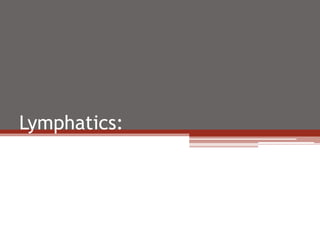The lymphatic system consists of lymph fluid, lymphatic vessels, lymph nodes, the spleen, thymus, and lymphatic tissues. It works with the immune and circulatory systems to drain excess interstitial fluid, transport lipids and proteins, and help fight infection through immune responses. Lymphatic vessels begin as tiny blind-ended capillaries that transport lymph through lymph nodes and eventually into the bloodstream via the thoracic duct or right lymphatic duct. The lymph nodes, spleen, thymus, tonsils, and Peyer's patches contain lymphatic tissues that help the immune system respond to pathogens and antigens.













































































